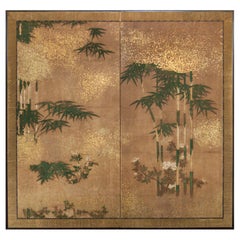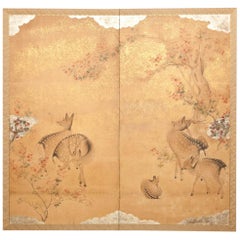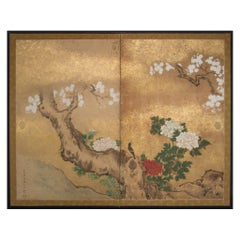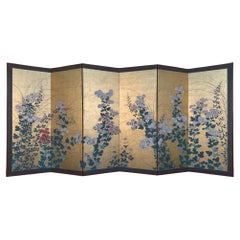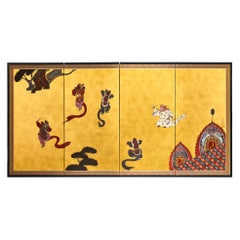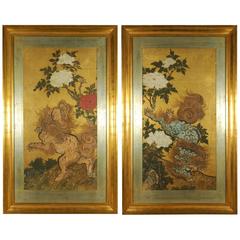Gold Paintings and Screens
to
6
150
29
232
18
2
1
63
110
59
20
21
12
4
2
1
2
3
2
12,600
766
736
701
525
244
235
221
13
6
252
245
249
6
2
1
1
1
Material: Gold
Japanese Two Panel Screen: Bamboo Grove on Mulberry Paper with Gold Dust
Located in Hudson, NY
Kano School painting of a bamboo grove with blooming flowers and gold dust mists. Painted in mineral pigments on mulberry paper with gold dust and a silk brocade border.
Category
Early 19th Century Japanese Antique Gold Paintings and Screens
Materials
Gold
Japanese Two Panel Screen Nara Deer in Gentle Yoshino Landscape
Located in Hudson, NY
Japanese two panel screen: Nara Deer in Gentle Yoshino Landscape. Yoshino is in the Nara Prefecture, an area famous for these small and tame deer native to J...
Category
Early 1900s Japanese Meiji Antique Gold Paintings and Screens
Materials
Gold Leaf, Silver Leaf
Japanese Two-Panel Screen Peony and Cherry
Located in Hudson, NY
Japanese two-panel screen: Peony and Cherry, Edo period (circa 1800) painting, formerly fusuma (Japanese sliding doors), executed in the Kano school style, featuring a cherry tree in...
Category
Early 1800s Japanese Edo Antique Gold Paintings and Screens
Materials
Gold Leaf
Early 19th Century Rimpa School Floral Screen
By Rimpa School
Located in Fukuoka, JP
Early 19th Century Rimpa School Floral Screen
Period: Early 19th Century
Dimensions: 367x171 cm (144.5x67.3 inches)
SKU: RJ118/2
This 6-panel gold-leafed screen is a splendid repre...
Category
Early 19th Century Japanese Edo Antique Gold Paintings and Screens
Materials
Gold Leaf
Japanese Four Panel Screen: Dancing Figures
Located in Hudson, NY
People dressed in ceremonial robes and masks celebrate the New Year. On New Year's eve a traditional Japanese custom is to ward off evil spirits by pretending to chase away people w...
Category
20th Century Japanese Gold Paintings and Screens
Materials
Gold, Gold Leaf
Pair of Antique Japanese Paintings of Karashishi, Edo Period, 18th Century
Located in Prahran, Victoria
A rare pair of antique Japanese Karashishi paintings in a landscape of rocks and peony flowers on gold leaf ground in fine handmade frames, Edo period, early 18th century. The Karash...
Category
Early 18th Century Japanese Edo Antique Gold Paintings and Screens
Materials
Gold Leaf
Japanese Two Panel Screen: Trees in Floral Landscape
Located in Hudson, NY
Japanese Two Panel Screen: Trees in Floral Landscape, Edo period painting (mid 19th century) of pine and other trees amongst flowers, with bamboo shoots on the right panel, and white...
Category
Mid-19th Century Japanese Antique Gold Paintings and Screens
Materials
Gold Leaf
Vintage kimono textile art "Marble Story ~ Healing ~" by ikasu Grey, Japan
By Kimono ikasu
Located in Setagaya City, JP
This work uses a vintage kimono fabric with marble pattern, that makes it look like a real piece of marble.
The line in the middle symbolizes “kintsugi” - concept of wabi-sabi, which values imperfection, impermanence, and the beauty of aging.
It is elegantly framed with paulownia wood originally used for kimono chest-of-drawers, and is filled with storytelling and sense of luxury.
I used pieces of kimono that could no longer be used as clothing and kiritansu chest-of-drawers that would normally be discarded to create the ultimate upcycled piece.
<< Explanation and meaning of pattern and colors >>
Kintsugi (金継ぎ), which translates to "golden joinery" or "golden repair," is a traditional Japanese art form of repairing broken pottery with lacquer mixed with powdered gold, silver, or platinum. I used this tecnique here to "repair" antique kimono by transforming it into art work. Beyond its literal meaning of mending broken ceramics, kintsugi carries profound philosophical and cultural significance in Japanese tradition:
・Embracing Imperfection: Kintsugi celebrates imperfection and impermanence. Rather than disguising or concealing flaws, it highlights them, treating the breakage as part of the object's history. This philosophy encourages acceptance of imperfection as an essential aspect of life, beauty, and human experience.
・Wabi-Sabi Aesthetic: Kintsugi embodies the principles of wabi-sabi, an aesthetic worldview centered on the acceptance of transience and imperfection. Wabi-sabi values simplicity, authenticity, and the beauty of things that are imperfect, impermanent, and incomplete. Kintsugi exemplifies these principles by turning what might be considered flaws into features that enhance the object's beauty and character.
・Resilience and Transformation: The act of repairing broken things with precious metals symbolizes resilience and transformation. Instead of discarding or replacing the broken object, kintsugi honors its history and transforms it into something new and valuable. This reflects broader philosophical themes of overcoming adversity, finding beauty in imperfection, and embracing change.
・Honoring the Past: Kintsugi preserves and honors the history of the object. Rather than erasing or ignoring its past, it acknowledges and celebrates it. This aspect of kintsugi can be seen as a metaphor for honoring our own personal histories, including the challenges and setbacks we have faced, and recognizing how they have shaped us into who we are today.
・Spiritual and Philosophical Symbolism: Kintsugi has spiritual and philosophical implications, reflecting concepts such as the interconnectedness of all things, the cycle of life and death, and the pursuit of harmony and balance. The process of repairing broken objects with precious metals is seen as a metaphor for spiritual growth, enlightenment, and the journey towards wholeness.
Overall, kintsugi represents not only a practical technique for repairing ceramics but also a profound philosophical and cultural perspective on life, beauty, and the human experience. It embodies values such as resilience, acceptance, and the transformative power of embracing imperfection.
<< Characteristics of the fabric >>
This vintage textile is hand-painted with a traditional painting technique where the colors are added on wet surface, which creates an effect of marble.
<< About the frame >>
Kiritansu - chest-of-drawers for kimono, is traditionally made from paulownia wood, a uniquely Japanese material closely tied to the world of kimonos.
Paulownia wood is known as the lightest wood in Japan, prased for its natural luster, resistance to moisture, and resilience against cracking. Since ancient times, it has been used in crafting furniture, chests, and musical instruments.
During the Edo period, it became customary to store cherished kimonos in paulownia chests...
Category
1960s Japanese Japonisme Vintage Gold Paintings and Screens
Materials
Gold Leaf
Japanese Two Panel Screen: Painted Fans on Gold Leaf
Located in Hudson, NY
Mineral pigments on gold leaf with brocade border. Calligraphy and sketching on back paper.
Category
Late 19th Century Japanese Antique Gold Paintings and Screens
Materials
Gold Leaf
Japanese Three Panel Framed Gold Black White Porcelain Artwork by Master Artist
Located in Takarazuka, JP
Extraordinary Japanese contemporary three-panel framed porcelain artwork in gold, black and white. This is a masterpiece by a third generation master porcelain artist in the Imari-Arita region of Japan who is the descendant of an extended family of prolific porcelain and ceramic artists. The artist's profile is available upon request.
The kiln started in the 19th century with traditional kinrande techniques (gold enameled porcelain), but in accordance with the philosophy of the kiln’s founder, each subsequent generation pioneered in a field of the master’s choosing. Thus, the second generation is known for its yuri-kinsai (gold foil underglaze) and the third generation for its haku-yui (intertwining of precious-metal foils).
Yuri-kinsai was termed in the 1950s as a new glazing technique. The main feature is a highly transparent overglaze on the gilded porcelain, cutting out stencils of gold foil for underglaze decorations.
In this exceptional work, the artist has used gold leaf, black and white for expressing the dramatic scene of Tawaraya Sotatsu's influential "Wind God and Thunder God" that is considered a Japanese National Treasure. It is a pair of two-folded screens using...
Category
21st Century and Contemporary Japanese Meiji Gold Paintings and Screens
Materials
Gold Leaf
An Indian miniature painting depicting a prince surprising bathing maidens
Located in Amsterdam, NL
India, Punjab, circa 1755
Signed by the artist Swami 'Ram Rikh' of Seopur and dated Samvat 1812 (1755)
Opaque watercolour and gold on paper,
H. 23.8 x W. 16.2 cm (image)
H. 28.3 x ...
Category
18th Century Indian Antique Gold Paintings and Screens
Materials
Gold
Japanese Two Panel Screen Peonies In the Mist
Located in Hudson, NY
Japanese Two Panel Screen: Peonies In the Mist. Showa period (1926 - 1945) painting in oil on canvas of peonies with gold and silver dust clouds. Signature reads, Seishu.
Category
1930s Japanese Showa Vintage Gold Paintings and Screens
Materials
Gold Leaf, Silver Leaf
Japanese Six Panel Screen Mother Cat and Kittens Near Rushing Stream
Located in Hudson, NY
Kano School painting, in mineral pigments and gold leaf on mulberry paper with a silk brocade border. Artist seal reads: Hokkyo Unsen.
Category
Early 19th Century Japanese Antique Gold Paintings and Screens
Materials
Gold Leaf
Japanese Two Panel Screen: Nadeshiko on Bamboo Trellis
Located in Hudson, NY
Nadeshiko, also known as fringed pinks is a flowering plant native to Japan. Ink, mineral pigments and 18th century gold leaf, with good veining, on mulbe...
Category
18th Century Japanese Antique Gold Paintings and Screens
Materials
Gold, Bronze, Gold Leaf
18th Century Japanese Two-Panel Screen Collection of Fans on Gold
Located in Hudson, NY
18th century Japanese Screen of a Collection of Fans. Paintings on fans depict famous Japanese painting subjects, this screen was most li...
Category
18th Century Japanese Edo Antique Gold Paintings and Screens
Materials
Gold Leaf
Japanese Two Panel Screen: Mountain Landscape With Cedar and Pine on Gold Leaf
Located in Hudson, NY
Kano School painting, reminiscent of early Kano School paintings, in sumi (ink) and minimal pigments on gold leaf with a silk brocade border.
Category
Early 19th Century Japanese Antique Gold Paintings and Screens
Materials
Gold Leaf
Japanese Two Panel Screen: Simple Chrysanthemums on Gold
Located in Hudson, NY
Mineral pigments on gold leaf. Not signed, by: Baikei Hitsu.
Category
1880s Japanese Antique Gold Paintings and Screens
Materials
Gold Leaf
Japanese Two Panel Screen: Family of Chickens on Gold Leaf
Located in Hudson, NY
Mineral pigments on gold. Not signed, by Baikei Hitsu.
Category
1880s Japanese Antique Gold Paintings and Screens
Materials
Gold Leaf
Japanese Two Panel Screen: Mandarin Ducks and Geese Among Bamboo and Flowers
Located in Hudson, NY
Japanese Two Panel Screen: Mandarin Ducks and Geese Among Bamboo and Flowers, Edo period painting (c. 1850) of mandarin ducks and geese on a grassy sh...
Category
Mid-19th Century Japanese Edo Antique Gold Paintings and Screens
Materials
Gold
Japanese Two Panel Screen: Sun over Cresting Waves with Golden Clouds
Located in Hudson, NY
Sun rising over cresting waves through tropical trees. Mineral pigments on mulberry paper with gold dust and brocade.
Category
Early 20th Century Japanese Gold Paintings and Screens
Materials
Gold
Japanese Six-Panel Screen "Mother and Her Kittens"
Located in Hudson, NY
Japanese six-panel screen: Mother and her kittens under flowering cherry tree.
Kano School painting, mineral pigments on gold, with beautiful early bronze mounts.
Category
Late 18th Century Japanese Antique Gold Paintings and Screens
Materials
Gold Leaf
Japanese Six Panel Screen: Waka Poems on Basketry Design
Located in Hudson, NY
Ribbons of 17th century calligraphy poems are mounted on an 18th century screen with a woven bamboo motif. These poems are aristocratic Waka poem...
Category
17th Century Antique Gold Paintings and Screens
Materials
Gold, Bronze, Gold Leaf
Japanese Six Panel Screen: Scenes in and Around Kyoto, 'Rakuchu Rakugai-Zu'
Located in Hudson, NY
The left two panels is the intersection of the Tokaido (an important and historical road that connects Kyoto with Tokyo) at Sanjo (Sanjo translates to "Third Street" and is the main ...
Category
18th Century Japanese Antique Gold Paintings and Screens
Materials
Gold Leaf
Japanese Asian Signed Four-Panel Folding Byobu Showa Screen Lady Murasaki Genji
Located in Studio City, CA
A gorgeous and quite striking four-panel Japanese Byobu folding screen featuring an elegantly clad Lady Murasaki, the Japanese novelist, (and famed author of the classic "Tale of Gen...
Category
Mid-20th Century Japanese Showa Gold Paintings and Screens
Materials
Gold Leaf
Japanese Contemporary Gold Leaf Brown Framed Porcelain Panel by Master Artist, 3
Located in Takarazuka, JP
Exquisite museum quality Japanese contemporary framed porcelain panel art work consisting of three pieces intricately hand-painted showcasing a wintry ...
Category
21st Century and Contemporary Japanese Meiji Gold Paintings and Screens
Materials
Gold Leaf
Japanese Six-Panel Screen "Wild Grasses and Peonies by Rivers Edge"
Located in Hudson, NY
Japanese Six Panel Screen: Wild Grasses and Peonies by Rivers Edge. Early Meiji period (1868 - 1912) painting of a grassy knoll next to a running brook or river. A soft breeze is m...
Category
1880s Japanese Meiji Antique Gold Paintings and Screens
Materials
Gold Leaf
Japanese Two-Panel Screen, Mother and Kitten with Chrysanthemums
Located in Hudson, NY
Delicate painting of garden chrysanthemums with a fine gold mist. A cat grooms herself while a kitten plays with a chrysanthemum. Mineral pigments...
Category
Mid-19th Century Japanese Antique Gold Paintings and Screens
Materials
Gold
Japanese Two-Panel Screen, Pine, Cherry, and Maple
Located in Hudson, NY
Cherry blossoms and maples among ragged pines. Mineral pigments on mulberry paper with gold mist clouds. Completely remounted utilizing an antique silk brocade...
Category
Mid-19th Century Japanese Antique Gold Paintings and Screens
Materials
Gold, Bronze
Fade-Resistant Acrylic and Stainless Steel Outdoor Divider
By Myface
Located in Santo Tirso, PT
Houdini - Outdoor screen
The Houdini Screen is a modular partition that blends privacy with striking design. Composed of customizable panels in stainle...
Category
21st Century and Contemporary Portuguese Modern Gold Paintings and Screens
Materials
Gold Plate, Stainless Steel
Japanese Six-Panel Screen, Chrysanthemums and Twig Fence With Gold Flakes
Located in Hudson, NY
Rimpa School painting in mineral pigments with gofun and gold flakes on mulberry paper with a silk brocade border.
Category
19th Century Japanese Antique Gold Paintings and Screens
Materials
Gold
Japanese Contemporary Orange Black Cream Silk Two-Panel Folding Screen, 4
Located in Takarazuka, JP
Extraordinary Japanese contemporary two panel "byobu" or folding screen featuring genryoku style handcrafted silk raised kimono Japanese decorative art in Purple, blue, black and ora...
Category
21st Century and Contemporary Japanese Meiji Gold Paintings and Screens
Materials
Gold
Japanese Two-Panel Screen, Deer in Cedar Landscape
Located in Hudson, NY
Originally fusuma doors, three deer stand in a clearing in a pine forest with gold leaf mist. Mid Edo period painting in mineral pigments on gold leaf wi...
Category
18th Century Japanese Edo Antique Gold Paintings and Screens
Materials
Gold
Japanese Two Panel Screen: Mandarin Ducks in Winter
Located in Hudson, NY
Fine painting of a variety of waterfowl in rich mineral pigments on gold leaf with a silk brocade border.
Category
19th Century Japanese Antique Gold Paintings and Screens
Materials
Gold Leaf
Japanese Two Panel Screen: Ikebana
Located in Hudson, NY
Beautifully painted basket arrangement of flowers in vivid color. Mineral pigments on applied silver and gold in a silk brocade border with black lacquer trim.
Category
Early 19th Century Japanese Antique Gold Paintings and Screens
Materials
Gold Leaf, Silver Leaf
Japanese Two Panel Screen: Rooster and Hens in Windswept Landscape
Located in Hudson, NY
Late Meiji Period (1868 - 1912) painting with a wonderful use of gold dust on mulberry paper with a silk brocade border. Signature reads: Ryutei.
Category
Late 19th Century Japanese Antique Gold Paintings and Screens
Materials
Gold
Yamamoto Shunkyo (1871-1933) Japanese Framed Painting Pair, Carp and Bamboo
Located in Kyoto, JP
Two framed panels by Yamamoto Shunkyo depicting a carp (koi) leaping from a river.
Ink and gold leaf on paper.
Instinctively brushed in a freehand s...
Category
Early 20th Century Japanese Meiji Gold Paintings and Screens
Materials
Gold Leaf
Japanese Landscape Painting on Gilt Wood Panel
Located in Douglas Manor, NY
4013 Hand painted Japanese landscape on gilt wood panel.
Category
1950s Japanese Vintage Gold Paintings and Screens
Materials
Gold Leaf
$450 Sale Price
40% Off
Japanese Chinese Asian Two-Panel Byobu Folding Screen Ancestral Immortal Figures
Located in Studio City, CA
A gorgeous, quite large, boldly colored, and alluring hand-painted two-panel Chinese/Japanese/Asian Byobu folding screen depicting 18 exquisitely clad male ancestral or immortal figu...
Category
20th Century Gold Paintings and Screens
Materials
Gold Leaf
19th Century Indo-Persian Miniatures of Emperor Shah Jahan and Mumtaz Mahal
Located in Chapel Hill, NC
A pair (they are different sizes) of finely painted 19th century Indo-Persian portrait miniatures in their original gold leaf frames which appear to never have been opened. The Portr...
Category
Late 19th Century Indian Anglo Raj Antique Gold Paintings and Screens
Materials
Gold Leaf
Japanese Contemporary Red Black Cream Folding Screen Silk Brocade Kimono Art, 3
Located in Takarazuka, JP
Exceptional Japanese contemporary two panel "byobu" or folding screen featuring genryoku style handcrafted silk raised kimono Japanese decorative art in crimson red, black and gold o...
Category
21st Century and Contemporary Japanese Meiji Gold Paintings and Screens
Materials
Gold
Tibetan Thangka of Amitabha Buddha Hand Painted Gilded
Located in Somis, CA
One of our finest hand painted Tibetan Thangkas from Nepal. This extraordinary Thangka depicts 108 Buddhas with consorts in celestial court witnessing Amitabha's achievement of nirva...
Category
2010s Nepalese Gold Paintings and Screens
Materials
Gold Leaf
$1,125 Sale Price
50% Off
Pair of Japanese hinagata byôbu 雛形屏風 (small folding screens) with flower carts
Located in Amsterdam, NL
An amazing pair of six-panel hinagata byôbu (doll festival folding screens) with a continuous painting on gold leaf showcasing flower carts (hana’guruma) at the edge of a winding river.
Both laden with a large bamboo basket...
Category
Early 19th Century Japanese Antique Gold Paintings and Screens
Materials
Gold Leaf
Japanese Six-Panel Screen, Audubon Landscape with Maple and Pine
Located in Hudson, NY
This is a Kano school painting depicting autumn and winter
Mineral pigments with gold dust on mulberry paper.
Category
Mid-18th Century Japanese Antique Gold Paintings and Screens
Materials
Gold Leaf
Japanese Asian Six-Panel Folding Byobu Screen Landcape Bridge with Iris Flowers
Located in Studio City, CA
A gorgeous six-panel Japanese Byobu folding screen depicting a nature lake/landscape scene with a water walkway/angular bridge and blossoming iris flowers - perhaps an homage to the famed Irises screens...
Category
19th Century Japanese Edo Antique Gold Paintings and Screens
Materials
Gold Leaf
Pair of Japanese Edo/Tokugawa Screens Tale of Heiki
Located in Rio Vista, CA
Monumental pair of late 18th century Japanese Edo/Tokugawa period byobu screens depicting the battles between Taira and Minamoto. The screens have six panels each with individual sce...
Category
19th Century Japanese Edo Antique Gold Paintings and Screens
Materials
Brass, Gold Leaf
Vintage kimono textile art " Cranes ~ Kintsugi ~ " by ikasu White/Red/Gold Japan
By Kimono ikasu
Located in Setagaya City, JP
The frame for this work is made of paulownia wood taken from antique Kiritansu - chest-of-drawers for kimono.
I use antique kiritansu that can’t be used as furniture anymore to create basis and frames for my works. It adds them even more authentic atmosphere of traditional wabisabi spirit. Can you feel it?
The piece uses the concept of "kintsugi" - it "unites" the pieces of antique kimono back together with golden leaf to give it a second wind as art work.
<< Period / Story >>
The kimono used in this piece was originally crafted during the late Showa period (1960-80ies).
<< Explanation and meaning of pattern and colors >>
The Japanese saying goes, "A crane lives a thousand years, a tortoise lives ten thousand years," making cranes a symbol of longevity.
Cranes are also known for staying with the same partner for their entire lives, which is why they are often used at weddings and other celebrations to symbolize "marital bliss" and the desire for harmony between husband and wife.
On this particular piece, cranes are flying through snow woven on the fabric, as if they are overcoming all the disasters to get to their beloved ones.
The color scarlet, or deeply dyed red, used for the most of the cranes here, has long been associated with the meaning of "warding off evil." It is believed to possess the power to repel malevolent forces and invite good fortune.
During the Heian period, scarlet was reserved for sacred buildings and ceremonial objects that held great significance. Ordinary people were prohibited from wearing scarlet-red kimonos, which made it a highly special color.
<< Characteristics of the fabric >>
Cranes, going up and down, are generously decorated by kimpaku here. "Kimpaku" (金箔) refers to gold leaf/foil in Japanese. Gold leaf is a traditional material used in various aspects of Japanese culture, including art, crafts, and even in culinary applications.
In traditional Japanese art, gold leaf is often applied to religious objects, sculptures, paintings, and lacquerware to create a luxurious and decorative effect. The use of gold leaf in art dates back centuries and is associated with a sense of wealth, prestige, and the divine.
Traditional kimpaku technique is used here to make an accent decoration in the middle.
<< About the frame >>
This artwork frame is crafted from paulownia wood, a uniquely Japanese material closely tied to the world of kimonos, and it serves to convey the refined beauty of Japanese nature.
Paulownia wood is known as the lightest wood in Japan, prased for its natural luster, resistance to moisture, and resilience against cracking. Since ancient times, it has been used in crafting furniture, chests, and musical instruments.
Paulownia wood is closely linked to kimono culture. During the Edo period, it became customary to store cherished kimonos in paulownia chests...
Category
Late 20th Century Japanese Japonisme Gold Paintings and Screens
Materials
Gold Leaf
Japanese Contemporary Framed Green Red Black Gold Decorative Art
Located in Takarazuka, JP
Exquisite Japanese contemporary framed three-dimensional decorative art piece in Japanese silk kimono fabric in vivid red, green and black on gold leaf Japanese paper, recreating a s...
Category
21st Century and Contemporary Japanese Meiji Gold Paintings and Screens
Materials
Gold Leaf
Majestic Hawks Edo Screen by Tosa School
Located in Fukuoka, JP
Majestic Hawks Edo Screen
Period: Edo
Size: 150x168 cm (59x66 inches)
SKU: PTA93
Step back in time to the Edo period with our superb Tosa school screen d...
Category
19th Century Edo Antique Gold Paintings and Screens
Materials
Gold Leaf
Japanese Six Panel Screen: Black and Gold Lacquer Flower Festival Cart
Located in Hudson, NY
Abundant flower arrangement of peonies in a basket, with a four legged rest to the right and a twig fence to the left. Fine lacquer ceremonial cart with silk ties and areas of raised...
Category
Early 19th Century Japanese Antique Gold Paintings and Screens
Materials
Gold Leaf
Elegant Edo period painting by Reizei Tamechika (1823-1864) 冷泉為恭
Located in Fukuoka, JP
Elegant Edo period painting by Reizei Tamechika (1823-1864)
Period: Edo
Size: 113x53 cm
SKU: PTA147
Indulge in the elegance of the Edo period with our superb painting on silk, a m...
Category
19th Century Japanese Edo Antique Gold Paintings and Screens
Materials
Gold Leaf
Japanese Contemporary Silk Brown Black Cream Two-Panel Folding Screen, 3
Located in Takarazuka, JP
Extraordinary contemporary Japanese two-panel "byobu" or folding screen showcasing genryoku style handcrafted raised embroidered silk brocade kimono Japanese decorative art in autumn...
Category
21st Century and Contemporary Japanese Meiji Gold Paintings and Screens
Materials
Gold
Japanese Six Panel Screen: Hawk with Ancient Pine Overlooking Twig Fence
Located in Hudson, NY
Beautiful and dramatic Kano school painting of a hawk perched on a rock. With flowering cherry, peonies, pine and bamboo. Twig fence on the right is made of heavily oxidized silver...
Category
18th Century Japanese Antique Gold Paintings and Screens
Materials
Gold Leaf, Silver Leaf
Japanese Six Panel Screens: Pair of Festival Carts
Located in Hudson, NY
Antique Japanese screen with Festival Cart design. Edo period painting (First half of the 19th century) of one brown lacquer cart and one bla...
Category
Early 19th Century Japanese Edo Antique Gold Paintings and Screens
Materials
Gold Leaf
Antique kimono textile art " Peacock Feathers ~Royalty~ " by ikasu Blue , Japan
By Kimono ikasu
Located in Setagaya City, JP
This work uses an antique furisode (festive kind of kimono with long sleeves) with peacock feathers - a symbol of royalty and prosperity. Can be used both vertically and horizontally...
Category
Early 20th Century Japanese Japonisme Gold Paintings and Screens
Materials
Gold Leaf, Silver Leaf
Set of 8 Chinese Gouache Traditional Figure Paintings
Located in Queens, NY
Set of 8 Asian Chinese (19th century) gouache paintings of traditionally clad figures framed in modern gilt faux bamboo frames.
Category
19th Century Chinese Antique Gold Paintings and Screens
Materials
Gold Leaf
Meiji Chrysanthemum Masterpiece
Located in Fukuoka, JP
Step into a world of timeless beauty with our exceptional six-panel screen from the Edo-Meiji period. In impeccable condition, each panel features stunning paintings of chrysanthemum...
Category
19th Century Japanese Meiji Antique Gold Paintings and Screens
Materials
Gold
"View from the Terrace, " Mixed-Media by Yamin Young
By Yamin Young
Located in Houston, TX
Well listed Chinese Artist Yamin Young. "View from the Terrace". Mixed-media on handmade rice paper, mounted to the fabric base, protected by the plexiglas...
Category
Late 20th Century Chinese Other Gold Paintings and Screens
Materials
Gold Leaf
Mughal miniature portrait depicting Emperor Akbar and Jodha Bai, 19th Century
Located in Islamabad, PK
The Mughal miniature portrait, created with a single-hair brush on delicate rice paper and embellished with 24k gold water, depicts the noble Mughal Emperor Akbar and his esteemed consort, Jodha Bai. This exquisite artwork exemplifies the pinnacle of Mughal artistry, renowned for its intricate detail and luxurious use of materials.
At the center of the composition, Emperor Akbar is portrayed with an air of majestic authority and wisdom. He is dressed in regal attire, featuring rich textiles adorned with elaborate patterns. The gold water applied to his garments and accessories adds a shimmering, ethereal quality, highlighting the emperor's status and the richness of his attire. His turban is prominently adorned with a jeweled ornament, enhancing his royal presence. Akbar's expression is composed and contemplative, reflecting his reputation as a wise and benevolent ruler.
Beside him stands Jodha Bai, exuding grace and elegance. Her attire is a masterpiece of Mughal textile...
Category
Mid-19th Century Indian Anglo Raj Antique Gold Paintings and Screens
Materials
Gold Leaf
Set of Four Sliding Doors (Fusuma): Bamboo on Gold
Located in Hudson, NY
Meiji period (1868 - 1912) four separate fusuma doors (sliding doors) with paintings of bamboo trees. Can be hung separately, or together as shown. Signature in the process of bein...
Category
Late 19th Century Japanese Antique Gold Paintings and Screens
Materials
Gold, Bronze, Gold Leaf
Japanese Antique Six Panel Screen: Inside the Imperial Household
Located in Hudson, NY
Kano School painting depicting an interior with finery such as a lacquer table, silk textiles, and other paintings. The fusuma doors appear to be a famous...
Category
1890s Japanese Antique Gold Paintings and Screens
Materials
Gold Leaf
Recently Viewed
View AllMore Ways To Browse
Edo Scroll
Japanese Four Panel Silk Screen
Japanese Screen 20th Century Four Panel
Chinoiserie Art Panel
Chinese Dynasty Painting
Dali Marble
Four Panel Japanese Folding Screen
Chinese Coromandel Lacquer Screen
Meiji Cranes
Window Lattice
Japanese Brushes
18th Century Chinese Painting
Bird Silk Art
Chinese Gilt Wood Panel
Qing Dynasty Painting
Chinese Painting On Silk
Red Lacquer Panels
Tiger Screen
